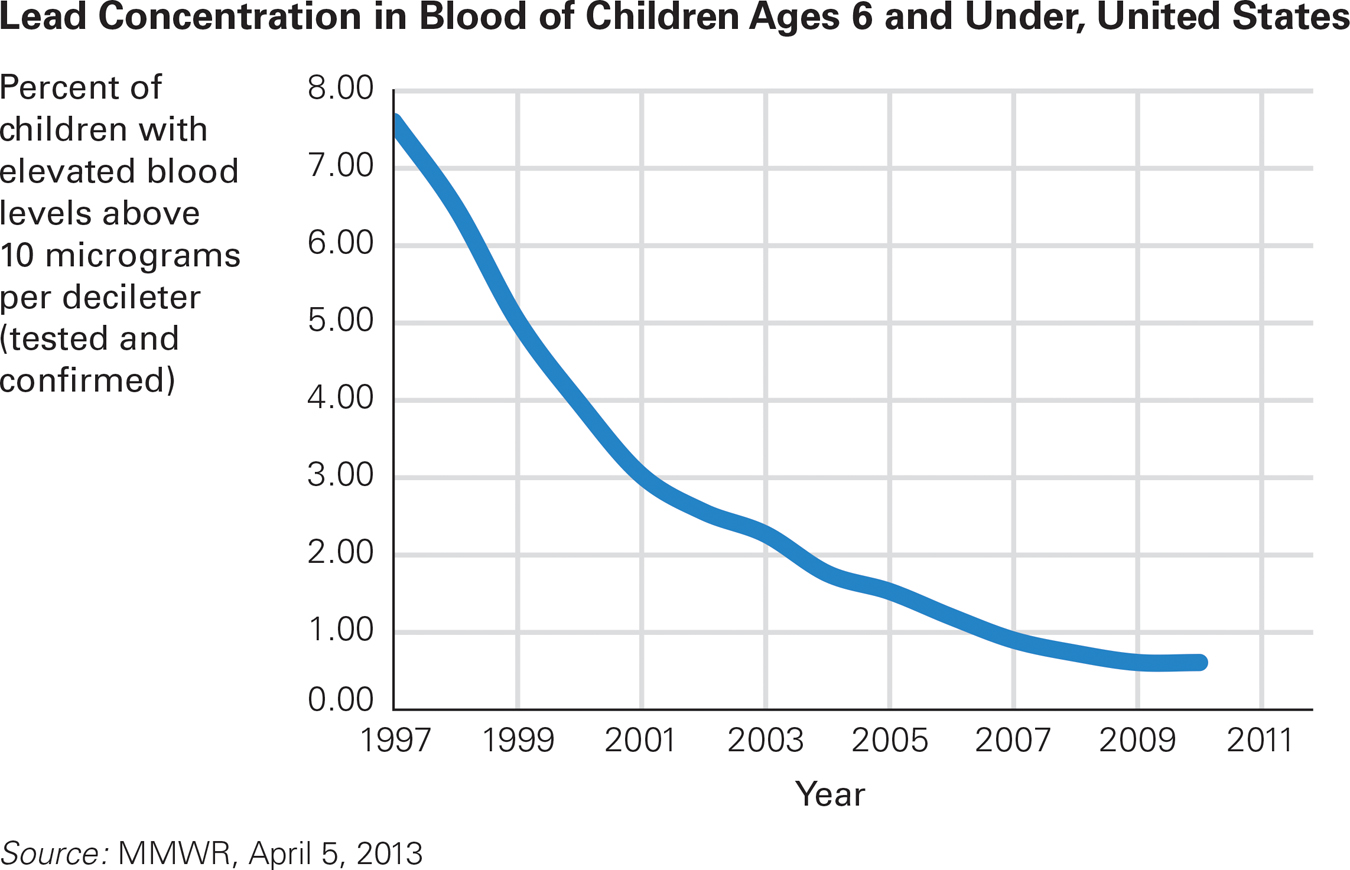Improving Motor Skills
Maturation of the prefrontal cortex allows impulse control, and myelination of the corpus callosum and lateralization of the brain permit better physical coordination. No wonder children move with greater speed, agility, and grace as they age (see Visualizing Development below).
Mastery of gross and fine motor skills results not only from maturation but also from extensive, active play. A study in Brazil, Kenya, and the United States tracked how young children spend their time. Cultural variations and differences based on socioeconomic status (SES) emerged, but at every income level in all three nations, children spent more time playing than doing anything else—
Gross Motor Skills
Gross motor skills improve dramatically. When playing, many 2-
There remains much for them to learn, especially in the ability to adjust to other people and circumstances. Thus a 5-
Specific Skills
Many North American 5-
VISUALIZING DEVELOPMENT
Developing Motor Skills
Every child can do more with each passing year. These examples detail what one child might be expected to accomplish from ages 2 to 6. But each child is unique, and much depends on culture, practice, and maturity.

Adults need to make sure children have a safe space to play, with time, appropriate equipment, and playmates. Children learn best from peers who demonstrate whatever the child is ready to try, from catching a ball to climbing a tree. Of course, culture and locale influence particulars: Some small children learn to ski, others to sail.

Recent urbanization concerns many developmentalists. A century ago, children with varied skill levels played together in empty lots or fields without adult supervision, but now more than half the world’s children live in cities. Many of these are “megacities … overwhelmed with burgeoning slums and environmental problems” (Ash et al., 2008, p. 739).
Crowded, violent streets not only impede development of gross motor skills but also add to the natural fears of the immature amygdala, compounded by the learned fears of adults. Gone are the days when parents told their children to go out and play, to return when hunger, rain, or nightfall brought them home. Now many parents fear strangers and traffic, keeping their 3-
That worries many childhood educators, who believe that children need space and freedom to play in order to develop well. Indeed, many agree that “Environment is the Third Teacher … because the environment is viewed as another teacher having the power to enhance children’s sense of wonder and capacity for learning” (Stremmel, 2012, p. 136).
Environmental Hazards
Observable dangers are not the only reason children are slower to develop skilled gross motor skills. Such skills require practice to develop, but children who breathe heavily polluted air tend to be impaired in brain development as well as to exercise less. Often they also live in crowded neighborhoods and attend poor schools. They have underdeveloped motor skills as well as more learning problems than children living where the air is clean. Are we certain that dirty air impairs their development, or is the cause really something else?
Scientists have grappled with this question and and found that environmental substances impair brain development in young children at every SES level, especially those in lower-
As you already know, the dynamic-
This study began with all births in 1999 and 2000 in southwest British Columbia (which includes a major city, Vancouver). For three years, 37,401 children were studied, 3,482 of whom were diagnosed with asthma by age 3. Each of those 3,482 was matched on SES, gender, and so on with five other children from the same group. Exposure to air pollution (including carbon monoxide, nitric oxide, nitrogen dioxide, particulate matter, ozone, sulfur dioxide, black carbon, wood smoke, car exhaust, and smoke from parents’ cigarettes) was carefully measured.
One finding was that parents could not always protect their children, partly because they did not know when substances caused poor health. For example, although carbon monoxide emissions are not visible, when compared to their five matched peers, those children who were diagnosed with asthma were more likely to live near major highways, where carbon monoxide is prevalent. Conversely, because wood smoke is easy to see and smell, some parents tried to avoid it, but burning wood did not increase asthma.
Respiratory problems are not the only early-
One recent concern is the contamination from e-
The administrator of environmental public health for the state of Oregon said, “We simply do not know—
Lead, however, has been thoroughly researched. There is no doubt that lead is severely toxic. The history of lead exposure in the following A View from Science illustrates the long path from science to practice.
a view from science

Eliminating Lead
Lead was recognized as a poison a century ago (Hamilton, 1914). The symptoms of plumbism, as lead poisoning is called, were obvious—
The lead industry defended the heavy metal. Manufacturers argued that low levels were harmless, and blamed parents for letting their children eat flaking chips of lead paint (which tastes sweet). Further, since children with high levels of lead in their blood were often from low-
Consequently, lead remained a major ingredient in paint (it speeds drying) and in gasoline (it raises octane) for most of the twentieth century. The fact that babies in lead-
Finally, chemical analysis of blood and teeth, with careful longitudinal and replicated research, proved that lead was indeed a poison for all children (Needleman et al., 1990; Needleman & Gatsonis, 1990). The United States banned lead in paint (in 1978) and automobile fuel (in 1996). The blood level that caused plumbism was set at 40 micrograms per deciliter, then 20, then 10, (and recently, danger is thought to begin at 5 micrograms), but no level has been proven to be risk-
Regulation has made a difference: The percentage of U.S. 1-

Dramatic Improvement in a Decade Once researchers established the perils of high lead levels in children’s blood, the percentage of children suffering from plumbism fell by more than 300 percent. Levels are higher in states that once had heavy manufacturing and lower in mountain and Pacific states.
Parents now take precautions. They are increasing their children’s calcium intake, wiping window ledges clean, testing drinking water, avoiding lead-
In some states (e.g., Colorado and Wyoming), average lead levels for young children are close to zero. In other states that once had extensive lead-
Remember from Chapter 1 that scientists sometimes use data collected for other reasons to draw new conclusions. This is the case with lead. About 15 years after the sharp decline in blood lead levels in preschool children, the rate of violent crime committed by teenagers and young adults fell sharply. Coincidence? Some scientists decided to test it. As it happened, some nations reduced lead in the environment sooner or later than others, and crime rates plummeted 15 years later in each nation. Teenagers with less lead in their blood as infants committed fewer crimes. Again this could be correlation, not causation, but this time researchers hesitate to make that argument.
A scientist comparing these trends concluded that some teenagers commit impulsive, violent crimes because their brains were poisoned by lead years ago. The correlation is found not only in the United States but also in every nation that has reliable data on lead and crime—
There is now no doubt that lead, even at quite low levels in the blood of a young child, harms the brain. That raises many other questions about the effects of brain damage, and about the long-
Fine Motor Skills
Fine motor skills are harder to master than gross motor skills. Whistling, winking, and especially writing are difficult. Pouring juice into a glass, cutting food with a knife, and achieving anything more artful than a scribble with a pencil all require a level of muscular control, patience, and judgment that is beyond most 2-
Many fine motor skills involve two hands and thus both sides of the brain: The fork stabs the meat while the knife cuts it; one hand steadies the paper while the other writes; tying shoes, buttoning shirts, cutting paper, and zipping zippers require both hands.
Limited myelination of the corpus callosum may be the underlying reason that shoelaces get knotted, paper gets ripped, and zippers get stuck. Short, stubby fingers add to the problem. As with gross motor skills, practice and maturation are key; using glue, markers, and scraps of cloth are part of the preschool curriculum. Puzzles—

Especially for Immigrant Parents You and your family eat with chopsticks at home, but you want your children to feel comfortable in Western culture. Should you change your family’s eating customs?
Children develop the motor skills that they see and practice. They will soon learn to use forks, spoons, and knives. Do not abandon chopsticks completely, because young children can learn several ways of doing things, and the ability to eat with chopsticks is a social asset.
Traditional academic learning depends on fine motor skills and body control. Writing requires finger control, reading a line of print requires eye control, classroom schedules require bladder control, and so on. These are beyond most young children, so even the brightest 3-
Slow maturation is one reason many 6-
Fine motor skills—
Many studies find that fine motor skills correlate with later school performance, which may be one reason that primary school girls typically outperform boys on tests of reading and writing. Although these gender differences seem to be biological, they may be the result of motivation and practice, as young girls are more likely to dress up and play with dolls (fine motor skills), while boys are more likely to climb and kick (gross motor skills) (Saraiva et al., 2013).
Artistic Expression
Young children are imaginative, creative, and not yet self-
All forms of artistic expression blossom during early childhood; 2-

For example when drawing a person, 2-
Cultural and cohort differences are apparent in all artistic skills. For the most part, Chinese culture incorporates the idea that drawing benefits from instruction, so young children are guided in how best to draw a person, a house, and—
Consequently, by age 9, Chinese children draw more advanced pictures than children of other cultures. Adult encouragement, child practice, and developing technical skill correlate with more mature, creative drawings a few years later (Chan & Zhao, 2010; Huntsinger et al., 2011).
Some parents enroll their preschool children in music lessons, hoping they will learn to play. As a result, those preschoolers become better at listening to sounds, evident in listening to speech as well as music. Neurological evidence finds that their brains reflect their new auditory abilities, a remarkable testimony to the role of family and cultural encouragement of preschool art (Strait et al., 2013).
SUMMING UP Maturation of the brain leads to better hand and body control. Gross motor skills advance every year as long as young children have space to play, older children to emulate, and freedom from environmental toxins. Sadly, crowding, fear of strangers, and pollution reduce the opportunities many contemporary children have to develop gross motor skills and may affect their overall learning, as well.
Young children also develop their fine motor skills, which prepares them for formal education. They love to dance, draw, and build, all encouraging the gradual mastery of arm and finger movements, which will be essential when they start to write. Gender differences, with girls ahead on average in fine motor skills and boys ahead in gross motor skills, may be biological or cultural.
WHAT HAVE YOU LEARNED?
Question 8.13
What three factors help children develop their motor skills?
The development of both gross and fine motor skills depends on brain maturation, motivation, and the opportunity to practice.Question 8.14
How have cohort changes affected the development of gross motor skills?
A century ago, children with varied skill levels played together in empty lots or fields without adult supervision, but now more than half the world's children live in cities. Many of these are “megacities . . . overwhelmed with burgeoning slums and environmental problems.” Crowded, violent streets not only impede development of gross motor skills but also add to the natural fears of the immature amygdala compounded by the learned fears of adults. Gone are the days when parents told their children to go out and play, to return when hunger, rain, or nightfall brought them home. Now many parents fear strangers and traffic, keeping their 3–to 5– year– olds inside. Observable dangers are not the only reason children are slower to develop skilled gross motor skills. Such skills require practice to develop, but children who breathe heavily polluted air tend to be impaired in brain development as well as to exercise less. Often they also live in crowded neighborhoods and attend poor schools. They have underdeveloped motor skills as well as more learning problems than children living where the air is clean. Question 8.15
What is known and unknown about the effects on young children of chemicals in food, air, and water?
Pollutants in the air and water may result in asthma and may affect the developing brain, and thus impede balance, finger dexterity, and motivation. Lead has been proven to cause brain damage and thus has resulted in laws governing acceptable levels in the air, food, clothing, soil, etc.Question 8.16
How does brain maturation affect children’s artistic expression?
Because they are imaginative, creative, and not yet self–critical, 2– to 6– year– olds love to express themselves. They love to dance, build with blocks, make musical rhythms, and make marks on paper. The corpus callosum, which allows a child to use and access both brain spheres, must be mature for artistic expression. Like other motor skills, artistic expression requires encouragement and practice. Question 8.17
What are conflicting interpretations of gender differences in motor skills?
Fine motor skills—like many other biological characteristics, such as bones, brains, and teeth— mature on average about six months earlier in girls than in boys. By contrast, boys often are ahead of girls in gross motor skills. Many studies find that fine motor skills correlate with later school performance, which may be one reason that primary school girls typically outperform boys on tests of reading and writing. Although these gender differences seem to be biological, they may be the result of motivation and practice, as young girls are more likely to dress up and play with dolls (fine motor skills), while boys are more likely to climb and kick (gross motor skills).